Places Visited: Wyoming: I-80 from Rock Springs to Little America,
US-30 from Little America to Kemmerer and Diamondville, and Fossil Butte National
Monument near Kemmerer then I-30 from Kemmerer to the Idaho state line.
July
21, 2006: Riverside RV-Park Kemmerer, Wyoming. N41° 47.825' W110° 32.085
$25.00 Full hookup 307-877-3416. Gravel interior roads and pads beside the Green
River.
July 22, 2006: Rendezvous RV-Park Montpelier, ID. N42° 19.698'
W111° 17.999 $19.20 Full hookup. Gravel interior roads and pads. Nothing fancy,
in fact the owner said that they were making a lumber mill out of the park in
three years and they were just getting income until the lumber mill. Still, the
KOA in Montpelier was $27 plus tax for 30-amps and water with ------- no sewage
at the site. We will take this place any day.
We left Rock Springs
heading west on I-80. The ride along I-80 through Rock Springs is at the bottom
of a huge cliff.

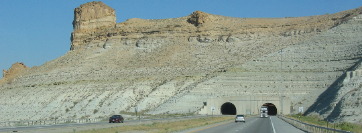
Most
of the time I-80 just hugs the cliff but at one point a few miles west of Rock
Springs the road builders blasted a tunnel through this imposing cliff instead
of winding around it. It is an impressive tunnel going through that huge rock
formation.
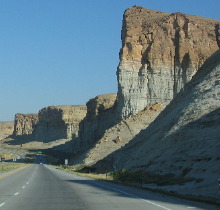
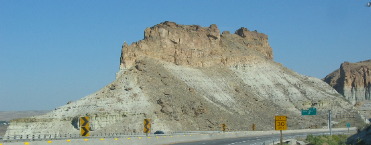
The
rock formations continue until we get to the west side of Green River.
We
turned north on US-30 about 20-miles west of Green River. We are heading to the
small town of Kemmerer, Wyoming.


Not
far north of I-80 on US-30 we passed through a large gas field.
For
10-miles or more all we saw on both sides of US-30 was sagebrush and gas well
equipment, pipes & tanks.

Gas fields are evident on both sides of the highway

A
closeup of a gas well & associated equipment.
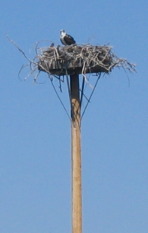
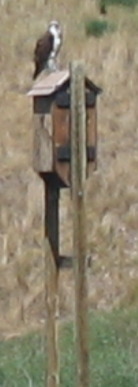
We
stayed in an RV-Park in Kemmerer that was on the Green River.
A block down
from where our RV was in Kemmerer we spotted this osprey platform with a parent
and several chicks. Daddy was purched on something not far away.
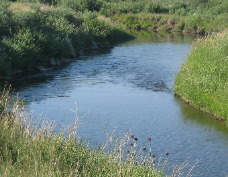
This
is the Green River that flows by our RV-Park and where the osprey get their fish.

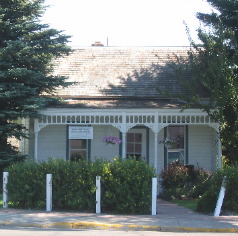
Kemmerer
is knows for having the first J.C. Penny store. The J.C. Penny store is still
there on the corner. The home that James C. Penny lived in when he operated that
store is just a block away from the store and it is maintained to this day by
the J.C. Penny Company.
We stopped by
the Kemmerer Historical Museum not long after arriving in Kemmerer. One of the
items in the museum that fascinated us was the "clothing" worn by a
man that was struck by lightening and lived to tell about it.
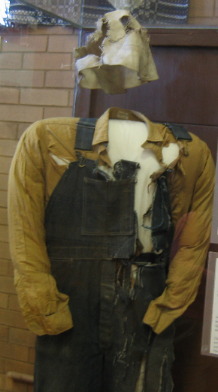
These
clothes were worn by Bert Sandberg when he was struck by lightening in 1928.
Bert
narrowly escaped death during the same electrical storm that claimed the life
of one and injured others. He was badly injured and hospitalized.
During
the storm Sandberg was riding a horse just north of Kemmerer. A bolt of lightning
struck the horse which he was riding killing the animal and freakishly treating
the rider. Sandberg's hat was torn and thrown fifty feet away. His clothing was
split from shoulder to heel in several places. His watch chain was melted and
welded onto the watch that he carried in his left shirt pocket. The watch was
not damaged except for the crystal being broken. This left a black spot over Sandberg's
heart. His head seemed to be injured, in fact his body was half paralyzed for
a while.
Unconscious for only a moment the badly injured Sandberg set out
to find help. Covered with blood from his nose, he partly walked, staggered and
finally crawled for nearly a mile to the highway where he was found by a passing
motorist who first carried him to a ranch house then to the hospital in Kemmerer.
Mr.
Sandberg lived another thirty six years in good health but carried the black spot
over his heart all his life. He was reported to be very nervous during thunder
storms after that experience. Well duh! I guess thunder storms would make most
of us nervous after that.

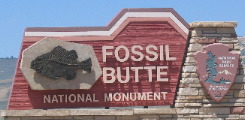
Later
that day we headed a few miles west of Kemmerer on US-30 to Fossil Butte National
Monument. That is Fossil Butte in the picture on the left.
Fossil
Butte and several other buttes in the area are rich in fish fossils. The rock
layers topping the high ridges of those buttes formed from sediments deposited
on the bottom of Fossil Lake about 50-million years ago.
The lake and its
encircling mountains basked in sub-tropical sunshine and bathed in torrential
rainstorms. Sometimes the lake overflowed. When its waters returned, loaded with
organic nutrients, the algae bloomed.
These abundant crops of algae furnished
the food essential to sustain the lake's species-diverese food chain.
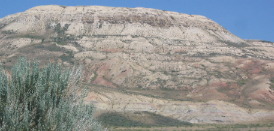
The
layer that contains the fish fossils is about 18" thick and located near
the top of several buttes in the area such as the one in this picture.
The
fossil fish of Fossil Lake may have been known to Indians and they may have been
noticed by fur trappers and early missionaries, but there is no record of this.
The first records of fossil fish in the Green River area of Wyoming were made
by United States Government sponsored scientist-explorers.
The scientific
exploration of the west began with Lewis and Clark and continues today. During
the nineteenth century scientists - naturalists, geologists, and paleontologists
- were part of military mapping expeditions, railroad surveys, and geologic surveys
of the territories. Their reports, published in Congressional Records and scientific
journals, describe in detail expanding knowledge of western geology and fossil
discoveries.
It was the work of these first scientist-collectors that brought
the attention of the world to the Green River Fossil fish.
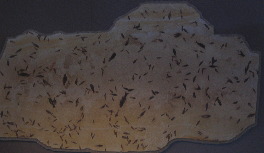
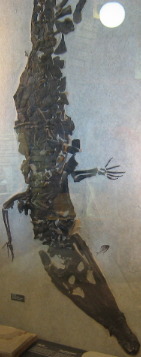
On
the left is a large slab with an entire school of small fish while on the right
is the fossil remains of a large crockadile.
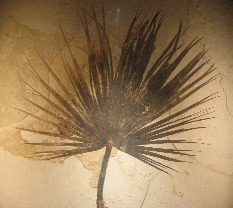
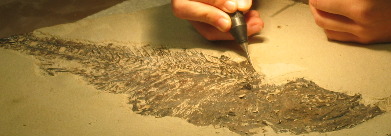
Everyone
can recognize this palm frond.
To the right a worker is using a very small
air driven jack hammer with a chisel point that is at most one eighth of an inch
in width. The operator has her eyes in a microscope with two eye pieces. The surrounding
rock is not as hard as the fossil itself. The object of the worker is to chisel
away the soft white rock thus exposing the darker fossil.
Fossil
Butte National Monument purchases fossil rocks from local quarries then employees
and interns spend time demonstrating how the fossil is chipped out of the surrounding
rock. It is one of the best demonstrations I have ever seen. There is a television
monitor just above where this lady is working that gives the view from the microscope
that the worker is using.
The rock layer containing these fossils is about
18" thick. In the quarry they dig over burden away to expose the top of this
18" layer. Then the top of the layer is inspected. They are looking for bumps
indicating backbones or possibly the outline of a fish. That is how they can tell
if a fossil is contained in a piece of rock.
The next step is to take a
power saw like the one most of us use to cut a 2X4 piece of lumber except the
saw has a different blade. With the saw they cut a pattern around the suspected
fossil about 1" deep. With the cut all the way around the fossil the next
step is to use several thin but rigid pieces of metal about 2" wide as a
wedge to pry the 1/2" slab containing the fossil from the 18" thick
mother layer. The sediments went down in layers and it is relatively simple to
use these thin wedges to separate the 1/2" piece from the mother layer. All
it takes is those wedges and a hammer, and of course a steady hand.

This
is another picture of Fossil Butte that is protected by the National Park Service.

Almost
all we know of life in Fossil Lake came from Quarries on Cundick Ridge, Fossil
Butte, Fossil Ridge and other nearby sites.
Commercial fossil fish mining
began in the last decades of the 19th century. Some specimens were sold as souvenirs,
and others -- the spectacular, the rare, the unusual -- went to museums throughout
the world.
A great body of knowledge about life in Fossil Lake accumulated
in these museums, much of which would never have come to light had it not been
for the collectors and their quarries.
Even today anyone wishing to can
visit one of these quarries and for $55 per-hour locate and extract the fossil
of their choice. That would certainly be an outstanding thing for a family to
do with children interested in fossils.
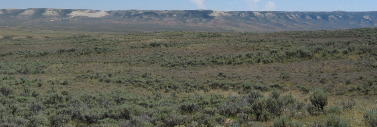
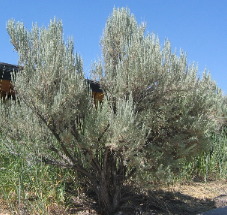
Fossil
Buttes National Monument is not all fossils. The property not on that butte is
sagebrush country as can be seen from this picture. On the right is a close-up
picture of a large silver sagebrush plant.
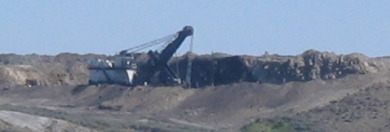
Between
the National Monument and Kemmerer we spotted this huge dragline operating in
what appears to be a coal mine. There were no signs indicating what type of operation
was going on and the gates were locked on the dirt road leading to the mine. It
will just have to be one of those things we might not ever know, but this is coal
mining country.

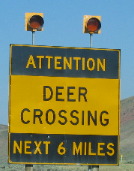
Trains,
trains and more trains. They are everywhere we are.
We have seen deer crossing
signs before but never one with blinking caution lights. This area is obviously
serious deer country although we did not see any within the six miles that the
sign was warning about.
As we headed out of Kemmerer on US-30
on our way to Montpelier, Idaho we passes some odd and rapidly changing geology.
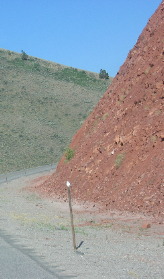
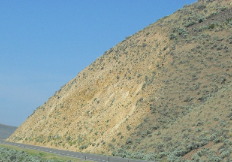
One
minute we are looking at roadcuts through red Triassic sandstone then around the
bend is a roadcut through yellow sandstone or possibly limestone from strata millions
if not hundreds of million years apart.

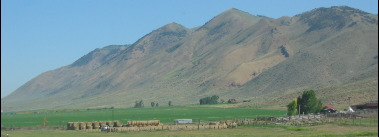
US-30
between Kemmerer and the Idaho border drops into a broad valley that is bright
green with irrigated alfalfa fields.
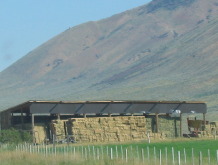

Ranchers
are making hay while the sun shines so they say. We understand that ranchers/farmers
are able to get two cuttings of alfalfa before the water runs out sometime in
August.
Until next time remember how good life is.
Mike
& Joyce Hendrix